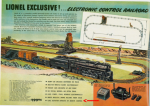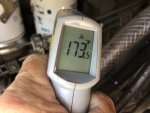I have a 1953 M37; I recently had to remove the throttle cable from the dashboard and after repairs were completed re install it. It was very tight working and after cramming it all back together I took a test drive. About 2 miles up the road I noticed that the temperature gage was reading 260 degrees. I pulled over, shut it down and fully expected to see steam pouring out of the radiator, but it was obvious that it was not over heating, and it had definitely not been operating at 260 degrees. So I drove it back to my house and parked it. I tried turning the ignition on and off a few times over the next few minutes and each time the temperature gage deflected to 260 or basically pegged. This morning however it did not deflect at all cold. I haven't tried starting it today yet.
In looking at the wiring diagram the circuit is very simple. +24 volts is fed to one side of the gage. The other side of the gage goes to a thermistor or temperature sensor which is mounted on the block under the oil filter. That thermistor must change resistance proportional to the temperature it is exposed to. The other side of the sensor goes to ground.
So before I pull the instrument panel again I was wondering if anyone had any information on the electrical characteristics of the gage, (meter), and the sensor. For instance with the gage on the bench what is the voltage necessary to deflect the gage to 260 degrees, or full scale? I'm thinking it has to be 24 volts. And also does anyone have or has anyone plotted the temperature vs. resistance curve for the thermistor? These two bits of information would really help me a lot in diagnosing this problem. Thanks, Lenny
In looking at the wiring diagram the circuit is very simple. +24 volts is fed to one side of the gage. The other side of the gage goes to a thermistor or temperature sensor which is mounted on the block under the oil filter. That thermistor must change resistance proportional to the temperature it is exposed to. The other side of the sensor goes to ground.
So before I pull the instrument panel again I was wondering if anyone had any information on the electrical characteristics of the gage, (meter), and the sensor. For instance with the gage on the bench what is the voltage necessary to deflect the gage to 260 degrees, or full scale? I'm thinking it has to be 24 volts. And also does anyone have or has anyone plotted the temperature vs. resistance curve for the thermistor? These two bits of information would really help me a lot in diagnosing this problem. Thanks, Lenny





